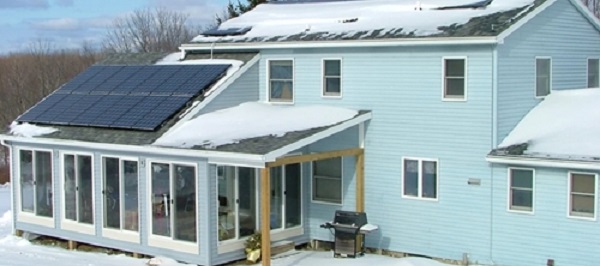Common sense often leads would-be solar buyers to believe that purchasing a PV system in cold, snowy climates is a foolish investment. With low temperatures and snow cover, how could a solar owner possibly get his or her money’s worth during the winter months?
Though these fears are not entirely misplaced, research has shown that winter solar may not be as problematic as it first appears.
Many would-be solar panel owners are put off by the thought that snowfall and cold will reduce the potential output of their solar arrays. While it is true that snow buildup can hamper a panel’s ability to produce, this dip in output is usually only significant in systems that are poorly optimized for snowy climates.
Snow cover will only reduce output if it’s thick enough to shelter the panels from sunlight. More often than not, snow will thaw and slide off angled panels, with the help of stored heat from the sun.
As a result, serious build up should only occur on non-tilted or slightly tilted panels (such as those in many rooftop applications). However, even if such buildup occurs, measures can be taken to restore them to operating capacity. Options to consider include automatic panel cleaning systems and hiring a company to sweep the snow away.
Those looking into PV systems also express concern about efficiency of their panels in the cold, but their concern is not founded in fact. Cold and snow have been shown to improve panel efficiency. A PV temperature reduction of about 20°C leads to a 9 to 12% increase in electrical yield.
Like other electronic devices, efficiency and temperature for solar panels are inversely related. In other words, the colder the temperature, the more efficiently panels will be able to operate. Also, fallen snow tends to reflect the sun’s light back upward. This reflected light, called albedo, hits angled panels, adding to the direct light from the sun and resulting in higher energy yields.
These two effects in combination can result in higher output from panels on a clear snowy day than the average summer day when one would expect output to be highest.
Even when factoring in the snowy cold months of the winter, a solar installation will assuredly help curb a consumer’s annual energy bill. To see this in action, look no further than Germany, where despite a frigid climate, residents have spearheaded the move toward renewable energy, making Germany the leading market for solar.
Of course, to help clients most effectively reap the rewards of the winter months and avoid being buried by the snow, it is important to effectively angle panels during installation.
Doing so will minimize snow buildup and maximize output from reflected light. If properly optimized, solar output in the winter can compete with that of other parts of the year, making solar the perfect energy source for homes in all climates.
Reference:
This article has been published here with permission by the PVbuzz team from the original article written by Chris Blevins and published on Solar Power World Online by Steven Bushong.
Chris Blevins earned a bachelor’s degree in Mechanical Engineering from Rensselaer Polytechnic Institute. After graduation, he traveled extensively and discovered the financial and environmental benefits of solar energy in rural developing nations. Upon returning to the United States, he co-founded online solar marketplace, Pick My Solar.














Comments